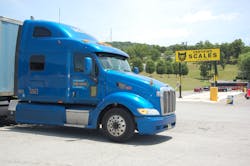On its surface, the theory of “gamification” seems a fairly straightforward one: Using game mechanics and dynamics to drive game-like engagement in a non-game context.
In trucking, for example, that can translate into setting up competitions between drivers, to see who can achieve the best fuel economy or record the lowest engine idle time.
Yet it’s not quite that easy, Roni Taylor, vice president of industry relations for telematics provider Spireon, explained to Fleet Owner.
“At its essence, you are using psychology to change human behavior – and using various motivations to trigger that behavior,” she said.
Michael Wu, principal scientist of analytics for software provider Lithium, stressed in a recent blog post that at its heart, “gamification” is not a game. In actuality, those involved in a “gamified” work activity shouldn’t know that they are actually playing a game, he noted.
[Here’s another view of how “gamification” could help re-imagine the concept of work.]
In Wu’s view, there are three key parts to putting gamification theory into practice:
- “The use of game attributes,” which includes game mechanics/dynamics, game design principles, gaming psychology, player journey, game play scripts and storytelling, and/or any other aspects of games
- “To drive game-like player behavior,” such as engagement, interaction, addiction, competition, collaboration, awareness, learning, and/or any other observed player behavior during game play
- “Used in a non-game context,” meaning that the aforementioned practices are deployed in settings other than a game, such in classrooms, workplaces, health and fitness routines, etc.
Spireon’s Taylor noted that those philosophies underpin its new Driver Performance Program, which is designed to boost fleet safety while reducing costs via a variety of metrics such as increased fuel economy, fewer hard-braking and hard acceleration events, among others.
“It’s about changing behaviors by using carrots instead of sticks,” she said. “The program is made to be engaging so drivers not only accomplish something either individually or as part of a team while also achieving a reward.”
For example, one Spireon client using its new “gamified” performance program created an 11 week “season” whereby teams of drivers compete against one another in a NASCAR-like point-system format.
[Indeed, Spireon has tapped the team experience of Joe Gibbs to illustrate how such information-based programs can improve trucking operations.]
Taylor said drivers download Spireon’s performance application to either a smart phone or tablet computer, log in with a specific user name and password, and then can begin monitoring in real-time their performance and their team’s overall performance against the others within the program – thus spurring them to make improvements.
Taylor added that the reward this one fleet offers for winning its 11 week “Safety Cup” is easily appreciated by its drivers: cold, hard cash.
“They get trophies and cash for winning – and that’s worth every penny to this company,” she noted, as the savings from reduced accidents due to safer driving combined with lower fuel consumption more than cover the cost of such rewards.
“Drivers also don’t feel like they are being watched by Big Brother,” Taylor pointed out. “’Gamification’ is way around that. And it also appeals to Millennials as they are a generation that’s heavily into gaming. That’s why it will be become more critical as ‘being monitored’ as a driver becomes more of a daily reality, from ELDs [electronic logging devices] to other systems.”
About the Author
Sean Kilcarr
Editor in Chief
Sean Kilcarr is a former longtime FleetOwner senior editor who wrote for the publication from 2000 to 2018. He served as editor-in-chief from 2017 to 2018.
